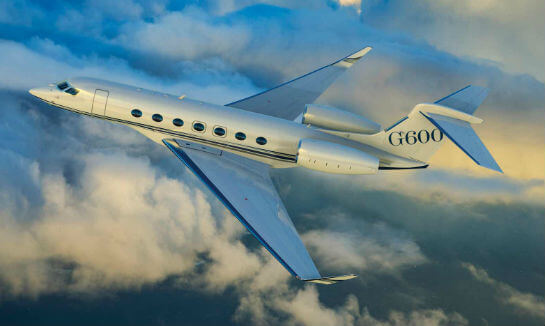Estimated reading time 18 minutes, 30 seconds.

Gulfstream’s newest models, the G500 and G600, represent the latest and greatest in business aviation–but also an approach to doing business that has served Gulfstream well for nearly 60 years. Paul Bowen Photo
The history of aircraft design is one of increasing sophistication, but it’s also one of increasing simulation. The first flight of a new model has always been a high-stakes enterprise, but as aircraft have become more complex and expensive, those stakes have gotten ever higher. And so engineers have gotten ever more ingenious in finding ways to identify in advance what might go wrong–through models and wind tunnel testing, for example, and computer simulation.
But a simplified model always falls short of the real thing. When it comes to the complicated electronics and flight control systems on modern aircraft, the only way to make sure they’ll work is to put them together, then subject them to the thousand natural shocks that planes are heir to. Yet ’tis nobler to do so on the ground than in the air, at least at first. Thus aircraft development has come to encompass remarkably comprehensive mockups, which are tested exhaustively long before the actual aircraft takes to the skies.
Nowhere is this more evident than at the Gulfstream Research and Development campus in Savannah, Ga., a complex of offices and cavernous test hangars that have served as incubators for the company’s newest business jets, the G500 and G600. The G500, which made its maiden flight on May 18, 2015, has already logged more than 1,000 hours in its flight test program, but well over 48,000 hours of testing in ground laboratories, including a System Integration Bench (SIB) and Integration Test Facility (ITF) that integrate avionics and electrical systems, and an Iron Bird that combines mechanical, flight control, and hydraulic systems. In these, and in a Conceptual Advanced Simulation Environment (CASE) engineering flight simulator, Gulfstream’s engineers and test pilots have wrung out details of the fly-by-wire aircraft’s avionics and flight control laws, thoroughly exercised major components, and tested software changes in what test pilot Scott Martin described as “a rather diabolical fashion.”
It’s not overkill. When the G500 enters service, as it is expected to do in early 2018, it will become one of the most sophisticated business jets on the market–if not the most sophisticated. With a groundbreaking Symmetry Flight Deck incorporating active control sidesticks, the G500 and its slightly longer sibling, the G600 (which is close behind it in development) will launch revolutionary new technologies for a company that is already on the leading edge of aircraft design. It’s not only the gee-whiz advancements in the cockpit that have benefited from exhaustive simulation and laboratory testing. Gulfstream’s designers have been applying the same principles to enhance the passenger experience in the cabin, all in pursuit of the company’s mission “to create and deliver the world’s finest aviation experience.”
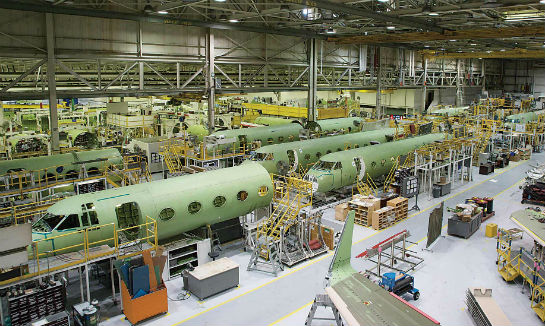
In addition to its headquarters in Savannah (pictured), Gulfstream has completion facilities in Appleton, Wis.; Brunswick, Ga.; Dallas, Texas; and Long Beach, Calif., and a parts manufacturing facility in Mexicali, Mexico. Gulfstream Photo
While the G500 and G600 represent the latest and greatest in business aviation, they also reflect an approach to doing business that has served Gulfstream well for nearly 60 years. The company’s commitment to excellence and history of delivering on its promises have helped establish it as a leader in its segment, particularly in recent years, as competitors have faltered. In a market in which capability, quality, and execution are key, Gulfstream is well positioned to retain its commanding presence.
Business aircraft specialists since 1958
Gulfstream traces its roots to the Grumman Aircraft Engineering Corporation, which rose to prominence during the Second World War as a maker of military aircraft. Grumman’s first purpose-built business aircraft, the Gulfstream I (GI), made its first flight in 1958 and entered service the following year. The turboprop GI was followed by the jet-powered GII, which made its first flight in 1966 and in 1968 became the first business jet to cross the Atlantic Ocean non-stop. Around the same time, Grumman moved its Gulfstream operations to Savannah, where the company remains headquartered today.
In the 1970s, following Grumman’s merger with American Aviation Corp., Gulfstream was sold to Allen Paulson of American Jet Industries, who became Gulfstream’s president and CEO. Paulson sold the company to Chrysler for a period in the 1980s, later buying it back in partnership with the private equity firm Forstmann Little & Co. In 1999, Gulfstream was acquired for US$5.3 billion by its current parent company, the aerospace and defence corporation General Dynamics, the original developer of the F-16 fighter jet. “General Dynamics is a great parent company for Gulfstream,” remarked Mark Kohler, Gulfstream’s vice president of Advanced Aircraft Programs. “They continue to invest in the R&D [research and development] activity . . . that’s a big part of our success.”
Today, Gulfstream has more than 15,000 employees spread across 12 major locations on four continents. It has put more than 2,500 jets into service, with the worldwide fleet growing by more than 1,100 aircraft over the past 10 years. And it has invested heavily in facilities to support this growth, putting close to US$1 billion into two major facility expansions in Savannah, in 2006 and 2010.
Around two-thirds of Gulfstream’s customers are corporations. Historically, most of these customers have come from the United States and Canada, and North America still represents around half of Gulfstream’s customer base. However, international sales have been growing, with the company seeing a particular uptick in orders from the Asia Pacific region in recent years. In the Greater China region–including China, Hong Kong, Macau, and Taiwan–Gulfstream claims more than 65 per cent of the large-cabin biz jet market share.
With six aircraft currently in production, Gulfstream offers a well-rounded product line that will become even more so with the introduction of the G500 and G600. At the low end are the mid-cabin G150 and G280, descendants of the Galaxy and Astra SPX models that Gulfstream rebranded as the G100 and G200 after purchasing them from Galaxy Aerospace in 2001.
The eight-passenger G150 can travel up to 3,000 nautical miles (5,556 kilometres) with a long-range cruise speed of Mach 0.75 and a high cruise speed of Mach 0.80. (Gulfstream itself uses two of them to support customers through its Field and Airborne Support Teams, or FAST.) The G150’s big brother, the 10-passenger G280, can travel up to 3,600 nautical miles (6,667 kilometres) with a long-range cruise speed of Mach 0.80 and a high cruise speed of Mach 0.84. Both airframes continue to be built in Israel by Israel Aerospace Industries.
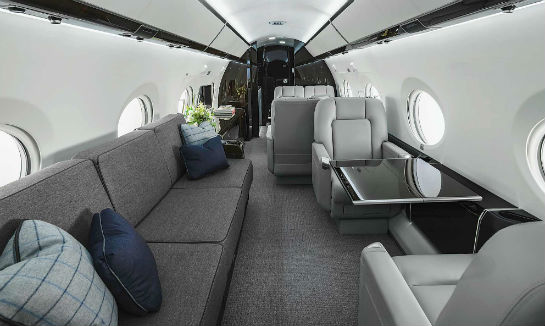
Gulfstream’s interiors are guided by a vision of “timeless elegance.” Customers can now choose from options including real stone flooring and countertop veneers. Kathy Almand Photo
Gulfstream’s presence in the mid-cabin market is not insignificant: there are now more than 110 G150s and 80 G280s in service. But the company remains better known for its large cabin aircraft, all of which are built in Savannah. The large cabin line starts with the G450, an evolution of the GIV airframe that incorporates some of the technological advances of the G550, including its PlaneView cockpit. With the ability to carry up to 16 passengers and a maximum range of 4,350 nm (8,056 km), the G450 can fly from Quebec to Moscow at Mach 0.80, or from Quebec to Rome at Mach 0.85. There are currently more than 330 G450s in service, boasting a dispatch reliability of 99.9 per cent.
Meanwhile, Gulfstream has fielded more than 530 examples of the G550, which entered service in 2003. The G550 boasts the same outstanding dispatch reliability as the G450, with seating for up to 19 passengers, a maximum range of 6,750 nm (12,501 km), and long-range and high cruise speeds of Mach 0.80 and 0.87, respectively. The G550 replaced Gulfstream’s previous long-range offering, the GV, which was honoured with the prestigious Robert J. Collier Trophy for advanced design and manufacturing techniques in 1997. More than just an evolution of that design, the G550 represented such a leap in technological advancement that it secured the Collier Trophy for Gulfstream again, in 2003.
The newest Gulfstream models currently in production are the ultra-fast, ultra-long-range G650 and G650ER, which have maximum ranges of 7,000 nm (12,964 km) and 7,500 nm (13,890 km), respectively, and long-range and high cruise speeds of Mach 0.85 and 0.90. The G650, which entered service in 2012, also won the Collier Trophy in 2014, making Gulfstream the only business jet manufacturer to have received the honour three times.

The G650ER is a G650 with added fuel capacity to increase mission range and flexibility. Certified by the FAA in October 2014, it received EASA certification this year. Paul Bowen Photo
With the G650ER capable of flying from Toronto to Tokyo at Mach 0.90, or Toronto to Cape Town at Mach 0.85, no other business aircraft can fly so far, so fast. Moreover, with the Bombardier Global 7000 and Global 8000 programs now delayed, Gulfstream should have this corner of the market to itself for at least the next few years. As General Dynamics CEO Phebe Novakovic put it in a recent earnings call, “The 650 has 100 per cent market share for a market it created, and from my perspective . . . it’s likely to remain in that position for the foreseeable future.” Currently, the G650 backlog extends well into 2018.
Powered by Pratt & Whitney Canada PurePower PW800 series engines, G500 and G600 models will slide into the middle of Gulfstream’s existing large cabin line, with projected maximum ranges of 5,000 nm (9,260 km) and 6,200 nm (11,482 km) respectively. (These figures have yet to be firmed up, but Novakovic made it clear to investors that “there is no 600ER . . . the G600 is the G600.”) With list prices of $44.65 million for the G500 and $55.65 million for the G600–compared to $68.8 million for the G650ER–the new models will offer customers the speed of the G650 series at a lower price point.
“In general, the speed is what we’re shooting for in the aircraft,” said Mike Cuson, director of the G500/G600 entry-into-service programs. He explained that the G500 and G600 were motivated, in part, by Gulfstream finding that its G650 customers were flying at Mach 0.90 “all the time.” And this wasn’t simply impatience on their part–when Gulfstream ran the numbers, it found that a typical customer flying 500 hours per year would save more than 50 hours of flight time by flying at Mach 0.90 rather than 0.80. “You’re going to save your maintenance costs 10 per cent in the calendar,” said Cuson. “You can make a financial case for flying fast.”
Cutting-edge technologies
Speed may be the principal selling point for the G500 and G600, but every new Gulfstream model is an opportunity for the company to push the limits of what’s possible in a business aircraft–to come that much closer to the ultimate aviation experience. And the company is taking full advantage of that opportunity with the G500 and G600, which incorporate several bold technological leaps.
Perhaps the most obvious advancement in the G500 and G600 is the introduction of active control sidesticks, which replace the traditional control column with an ergonomic joystick, leaving the space in front of the pilot clear. Sidesticks aren’t new in commercial aviation, but existing versions have serious pitfalls, as the 2009 fatal crash of Air France Flight 447 made clear. The Airbus A330 in that accident had pilot and co-pilot sidesticks that were not linked, so that a control input by one pilot was not immediately obvious to the other. In the Air France case, the junior of three pilots on board induced and sustained a stall by holding the stick back, a fact that his colleagues didn’t recognize until seconds before impacting the Atlantic Ocean.
By contrast, the sidesticks in the G500 and G600, developed by BAE Systems, are electronically linked so that movement of one control automatically induces a corresponding movement in the other, allowing each pilot to be fully aware of the other’s control inputs. As test pilot Scott Martin explained, “Basically what we’ve done is recreated the mechanical linkage that you know and love and have always taken for granted.” The sidesticks also move in response to inputs by the autopilot, and provide force feedback to the pilots.
Although active inceptors have previously been available on military aircraft, including the Lockheed Martin F-35, this is the first application of the technology in the civilian environment. Because the underlying design is significantly different than that for mechanically linked controls, it will not be retrofittable to Gulfstream’s existing production aircraft, although “I think as we go through the normal development cycle we will look for applications on future products,” said Mark Kohler.
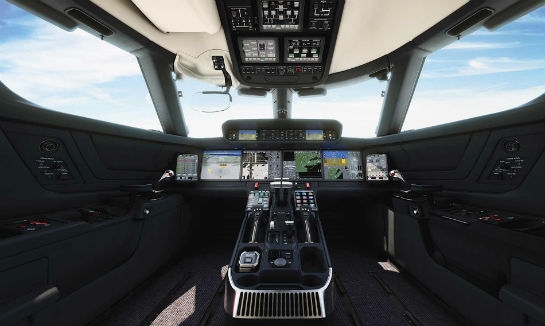
The cockpits of the G500 and G600 are identical. Pilots will receive a single type rating for both aircraft, allowing operators of mixed fleets to streamline their scheduling and save on training expenses. Josh Triplett Photo
The other big change in the cockpit is the use of integrated touchscreen panels that replace most of the buttons, knobs, and switches that typically reside on the centre pedestal and overhead panels–including those associated with the audio control panel, multi-function control and display unit, and standby multi-function controller. These complement more conventional flat panel displays based on the Honeywell Primus Epic platform. According to Cuson, “The use of that touchscreen technology is really what we feel is a game-changer.”
Gulfstream only made the decision to adopt touchscreens after concluding that the underlying technology was finally sufficiently advanced, and its engineers and pilots have put a lot of thought and effort into avoiding potential pitfalls. The touchscreens in the G500 and G600 use resistive rather than capacitive technology, and making a selection requires a deliberate touch of at least one-fifth of a second, which helps avoid inadvertent selections. Cyan blooms provide pilots with immediate confirmation of which button they pressed; if it was the wrong one, they can slide their finger off it to “back out of the mistake,” noted Martin.
Flight-critical actions are accomplished through dual-action switches, which force the pilot to confirm the selection at a different location on the screen. Input options are matched to the phase of flight, so that pilots don’t have the option to, say, open the main door during high-speed cruise. Finally, a raised border around each panel provides a place to steady one’s hand in turbulence.
The G500/G600 Integration Test Facility (ITF) has played a key role in developing the touchscreen system design. Gulfstream built its first ITF for the GV in 1995, and since then its ITFs have become increasingly sophisticated and comprehensive. Although they have historically focused on the cockpit, for the G500 and G600 Gulfstream extended the ITF concept to also encompass the cabin, since the cabin incorporates so many electronic elements.
In addition to the obvious innovations, the G500 and G600 have some behind-the-scenes advancements, notably a Data Concentration Network. As the “central nervous system” of the aircraft, it gathers individual system data through a distributed high-speed network and makes it available to other systems on the aircraft. Not only does this provide a higher level of data for aircraft trend monitoring, according to Cuson, “we eliminate miles and miles of wiring and all that weight.”

Gulfstream’s distinctive oval windows provide passengers with expansive views and lots of light. Gulfstream Photo
By simplifying and streamlining systems wherever possible, Gulfstream hopes to simplify maintenance, too. “Complexity is the enemy of reliability,” said Cuson. “We try to design in from the very beginning maintainability and dispatch reliability.” As with other recent designs, Gulfstream has used the Maintenance Steering Group-3 (MSG-3) process for the G500 and G600. As things stand now, the aircraft will have an interval of 750 hours between major inspections, which is 100 hours more than in the G650.
Looking ahead
At the 2016 European Business Aviation Convention and Exhibition (EBACE) in May, Gulfstream reported that the G500 and G600 programs were “on track” and “maturing at a consistent pace.”
At that time, the four flight-test aircraft in the G500 test fleet had surpassed a total of 1,000 flight hours over 240 flights, while the fifth test aircraft was at the Savannah completions centre receiving an interior for in-flight cabin testing. The first test aircraft, T1, had then flown more than 500 hours and reached a maximum speed of Mach 0.995, and a maximum altitude of 53,000 feet (16,154 metres).
Meanwhile, the first G600 test aircraft had seen its wing join completed and its empennage mated to the aircraft fuselage. Additionally, the wings for the structural test article had been moved to the G600 production facility, and that wing join completed.
Although Gulfstream is still projecting Federal Aviation Administration certification of the G500 in 2017, and G600 certification in 2018, the company has declined to narrow those timelines down further. In part, that is to avoid putting undue pressure on the flight test programs–a lesson the company learned after a fatal G650 crash in Roswell, N.M., in 2011. Four people were killed in that accident, which occurred when the aircraft experienced an aerodynamic stall and uncommanded roll during a one-engine-inoperative takeoff flight test. According to the U.S. National Transportation Safety Board, the accident was the result of “Gulfstream’s failure to properly develop and validate takeoff speeds for the flight tests,” with a contributing factor being the company’s “failure to effectively manage the G650 flight test program by pursuing an aggressive program schedule” without ensuring appropriate risk controls.
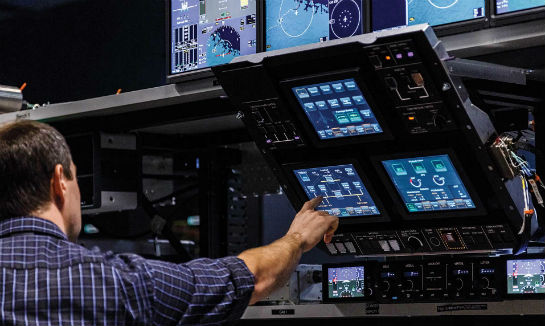
Most pilots are familiar with the adage, “Never fly the A model of anything.” With exhaustive laboratory testing now dramatically accelerating the maturation of its new products, Gulfstream aims to make that ‘A model’ stigma a thing of the past. Gulfstream Photo
Gulfstream communications manager Heidi Fedak acknowledged that the Roswell crash “is on everyone’s mind” as the G500 flight test program progresses. And the company has made a number of changes as a result of the accident, including the creation of an aviation safety officer position. Reporting directly to the president, the aviation safety officer is responsible for ensuring that safety processes have been developed and are being followed for all Gulfstream flight test and flight operations activities. The company also increased and bolstered the test organization, underwent external safety audits, and enhanced analysis for takeoff speed development.
“I think everyone learned something from [the accident],” said Fedak. “Safety has always been a priority at Gulfstream, but even more so after that.”
With the company’s focus still squarely on getting the G500 and G600 certified and into service, its leaders aren’t saying too much about what’s next on the horizon. And there’s probably no hurry for them to do so, given the competitive advantages in technology and capability represented by the G500, G600, and G650 product lines. But Gulfstream has a tradition of pursuing innovation behind the scenes and announcing the next big thing only when it’s good and ready–as the company did with the G500, which rolled out under its own power at the ceremony to announce it in 2014.
“Gulfstream does not make announcements at the whims of the market,” said Fedak. “And we have a long history of delivering on our promises.”
An FAA Gold Seal flight instructor with helicopter and instrument helicopter ratings, Elan holds commercial helicopter licences in the U.S., Canada and Australia. She is also an award-winning journalist who has written for a diverse array of magazines and newspapers since the late-1990s. She can be reached at [email protected][removed]/* <!–[CDATA[ */!function(t,e,r,n,c,a,p){try{t=document.currentScript||function(){for(t=document.getElementsByTagName(‘script’),e=t.length;e–;)if(t[e].getAttribute(‘data-cfhash’))return t[e]}();if(t&&(c=t.previousSibling)){p=t[removed];if(a=c.getAttribute(‘data-cfemail’)){for(e=”,r=’0x’+a.substr(0,2)|0,n=2;a.length-n;n+=2)e+=’%’+(‘0’+(‘0x’+a.substr(n,2)^r).toString(16)).slice(-2);p.replaceChild(document.createTextNode(decodeURIComponent(e)),c)}p.removeChild(t)}}catch(u){}}()/* ]]–> */[removed]
